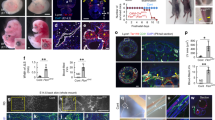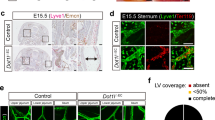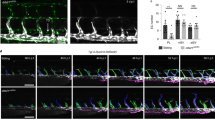Abstract
The lymphatic system plays a key role in tissue fluid regulation and tumour metastasis, and lymphatic defects underlie many pathological states including lymphoedema, lymphangiectasia, lymphangioma and lymphatic dysplasia1,2,3. However, the origins of the lymphatic system in the embryo, and the mechanisms that direct growth of the network of lymphatic vessels, remain unclear. Lymphatic vessels are thought to arise from endothelial precursor cells budding from the cardinal vein under the influence of the lymphatic hallmark gene Prox1 (prospero homeobox 1; ref. 4). Defects in the transcription factor gene SOX18 (SRY (sex determining region Y) box 18) cause lymphatic dysfunction in the human syndrome hypotrichosis-lymphoedema-telangiectasia5, suggesting that Sox18 may also play a role in lymphatic development or function. Here we use molecular, cellular and genetic assays in mice to show that Sox18 acts as a molecular switch to induce differentiation of lymphatic endothelial cells. Sox18 is expressed in a subset of cardinal vein cells that later co-express Prox1 and migrate to form lymphatic vessels. Sox18 directly activates Prox1 transcription by binding to its proximal promoter. Overexpression of Sox18 in blood vascular endothelial cells induces them to express Prox1 and other lymphatic endothelial markers, while Sox18-null embryos show a complete blockade of lymphatic endothelial cell differentiation from the cardinal vein. Our findings demonstrate a critical role for Sox18 in developmental lymphangiogenesis, and suggest new avenues to investigate for therapeutic management of human lymphangiopathies.
This is a preview of subscription content, access via your institution
Access options
Subscribe to this journal
Receive 51 print issues and online access
$199.00 per year
only $3.90 per issue
Buy this article
- Purchase on Springer Link
- Instant access to full article PDF
Prices may be subject to local taxes which are calculated during checkout




Similar content being viewed by others
References
Adams, R. H. & Alitalo, K. Molecular regulation of angiogenesis and lymphangiogenesis. Nature Rev. Mol. Cell Biol. 8, 464–478 (2007)
Carmeliet, P. Angiogenesis in health and disease. Nature Med. 9, 653–660 (2003)
Stacker, S. A. et al. Lymphangiogenesis and cancer metastasis. Nature Rev. Cancer 2, 573–583 (2002)
Wigle, J. T. et al. An essential role for Prox1 in the induction of the lymphatic endothelial cell phenotype. EMBO J. 21, 1505–1513 (2002)
Irrthum, A. et al. Mutations in the transcription factor gene SOX18 underlie recessive and dominant forms of hypotrichosis-lymphedema-telangiectasia. Am. J. Hum. Genet. 72, 1470–1478 (2003)
Bowles, J., Schepers, G. & Koopman, P. Phylogeny of the SOX family of developmental transcription factors based on sequence and structural indicators. Dev. Biol. 227, 239–255 (2000)
Hosking, B. M. et al. Cloning and functional analysis of the Sry-related HMG box gene, Sox18. Gene 262, 239–247 (2001)
Pennisi, D. et al. Mutations in Sox18 underlie cardiovascular and hair follicle defects in ragged mice. Nature Genet. 24, 434–437 (2000)
Carter, T. C. & Philipps, R. J. S. Ragged, a semi-dominant coat texture mutant in the house mouse. J. Hered. 45, 151–154 (1954)
Slee, J. The morphology and development of ragged — a mutant affecting the skin and hair of the house mouse. II. Genetics, embryology and gross juvenile morphology. J. Genet. 55, 570–584 (1957)
James, K. et al. Sox18 mutations in the ragged mouse alleles ragged-like and opossum. Genesis 36, 1–6 (2003)
Hosking, B. M. et al. SOX18 directly interacts with MEF2C in endothelial cells. Biochem. Biophys. Res. Commun. 287, 493–500 (2001)
Green, E. L. & Mann, S. J. Opossum, a semi-dominant lethal mutation affecting hair and other characteristics of mice. J. Hered. 52, 223–227 (1961)
Pennisi, D. et al. Mice null for Sox18 are viable and display a mild coat defect. Mol. Cell. Biol. 20, 9331–9336 (2000)
Wigle, J. T. & Oliver, G. Prox1 function is required for the development of the murine lymphatic system. Cell 98, 769–778 (1999)
Balconi, G., Spagnuolo, R. & Dejana, E. Development of endothelial cell lines from embryonic stem cells: A tool for studying genetically manipulated endothelial cells in vitro . Arterioscler. Thromb. Vasc. Biol. 20, 1443–1451 (2000)
Liersch, R., Nay, F., Lu, L. & Detmar, M. Induction of lymphatic endothelial cell differentiation in embryoid bodies. Blood 107, 1214–1216 (2006)
Garlanda, C. et al. Progressive growth in immunodeficient mice and host cell recruitment by mouse endothelial cells transformed by polyoma middle-sized T antigen: Implications for the pathogenesis of opportunistic vascular tumors. Proc. Natl Acad. Sci. USA 91, 7291–7295 (1994)
Hosking, B. M. et al. The VCAM-1 gene that encodes the vascular cell adhesion molecule is a target of the Sry-related high mobility group box gene, Sox18. J. Biol. Chem. 279, 5314–5322 (2004)
Sorokin, L. et al. Expression of novel 400-kDa laminin chains by mouse and bovine endothelial cells. Eur. J. Biochem. 223, 603–610 (1994)
Rodriguez-Niedenführ, M. et al. Prox1 is a marker of ectodermal placodes, endodermal compartments, lymphatic endothelium and lymphangioblasts. Anat. Embryol. (Berl.) 204, 399–406 (2001)
Wegner, M. From head to toes: The multiple facets of Sox proteins. Nucleic Acids Res. 27, 1409–1420 (1999)
Kamachi, Y., Uchikawa, M. & Kondoh, H. Pairing SOX off with partners in the regulation of embryonic development. Trends Genet. 16, 182–187 (2000)
Wilson, M. & Koopman, P. Matching SOX: Partner proteins and co-factors of the SOX family of transcriptional regulators. Curr. Opin. Genet. Dev. 12, 441–446 (2002)
Wilhelm, D. et al. Sertoli cell differentiation is induced both cell-autonomously and through prostaglandin signaling during mammalian sex determination. Dev. Biol. 287, 111–124 (2005)
Wilhelm, D. et al. SOX9 regulates prostaglandin D synthase gene transcription in vivo to ensure testis development. J. Biol. Chem. 282, 10553–10560 (2007)
Shayan, R. et al. A system for quantifying the patterning of the lymphatic vasculature. Growth Factors 25, 417–425 (2007)
Garlanda, C. et al. Characterization of MEC 14.7, a new monoclonal antibody recognizing mouse CD34: A useful reagent for identifying and characterizing blood vessels and hematopoietic precursors. Eur. J. Cell Biol. 73, 368–377 (1997)
Spagnuolo, R. et al. Gas1 is induced by VE-cadherin and vascular endothelial growth factor and inhibits endothelial cell apoptosis. Blood 103, 3005–3012 (2004)
Brummelkamp, T. R., Bernards, R. & Agami, R. A system for stable expression of short interfering RNAs in mammalian cells. Science 296, 550–553 (2002)
Follenzi, A. et al. Gene transfer by lentiviral vectors is limited by nuclear translocation and rescued by HIV-1 pol sequences. Nature Genet. 25, 217–222 (2000)
Dull, T. et al. A third-generation lentivirus vector with a conditional packaging system. J. Virol. 72, 8463–8471 (1998)
Leung, K. K. et al. Different cis-regulatory DNA elements mediate developmental stage- and tissue-specific expression of the human COL2A1 gene in transgenic mice. J. Cell Biol. 141, 1291–1300 (1998)
Acknowledgements
We thank A. Nagy, W. Abramow-Newerly, L. Naldini, P. Berta, A. Yap and J. Gamble for gifts of reagents. We also thank L. Bernard, L. Tizzoni and V. Dall’Olio for quantitative real-time PCR analysis, M. Chan and A. Pelling for antibody characterization, and S. Pizzi for technical assistance. Confocal microscopy was performed at the Australian Cancer Research Foundation Dynamic Imaging Centre for Cancer Biology. This work was supported by the National Health and Medical Research Council (Australia), INSERM (France), the Associazione Italiana per la Ricerca sul Cancro (Italy), the European Community (LSHG-CT-2004-503573, Eustroke and Optistem networks), the Pfizer Foundation (Australia), the Research Grants Council (Hong Kong), the Raelene Boyle Sporting Chance Foundation (Australia), the Royal Australasian College of Surgeons, the Heart Foundation of Australia, and the Australian Research Council.
Author Contributions M.F., A.C., B.H., F.O., D.W., C.B., K.P., T.K., R.S., M.D., T.D. and D.T. conducted the experiments, and K.S.E.C., S.A.S., G.E.O.M., M.G.A., E.D. and P.K. supervised the work.
Author information
Authors and Affiliations
Corresponding authors
Supplementary information
Supplementary Information
This file contains Supplementary Figures 1-9 with Legends, Supplementary Materials and Methods and Supplementary References. (PDF 1278 kb)
Rights and permissions
About this article
Cite this article
François, M., Caprini, A., Hosking, B. et al. Sox18 induces development of the lymphatic vasculature in mice. Nature 456, 643–647 (2008). https://doi.org/10.1038/nature07391
Received:
Accepted:
Published:
Issue Date:
DOI: https://doi.org/10.1038/nature07391
This article is cited by
-
The cytoskeleton adaptor protein Sorbs1 controls the development of lymphatic and venous vessels in zebrafish
BMC Biology (2024)
-
The development of early human lymphatic vessels as characterized by lymphatic endothelial markers
The EMBO Journal (2024)
-
Lymphatic vessel: origin, heterogeneity, biological functions, and therapeutic targets
Signal Transduction and Targeted Therapy (2024)
-
A Prox1 enhancer represses haematopoiesis in the lymphatic vasculature
Nature (2023)
-
Molecular and metabolic orchestration of the lymphatic vasculature in physiology and pathology
Nature Communications (2023)
Comments
By submitting a comment you agree to abide by our Terms and Community Guidelines. If you find something abusive or that does not comply with our terms or guidelines please flag it as inappropriate.



